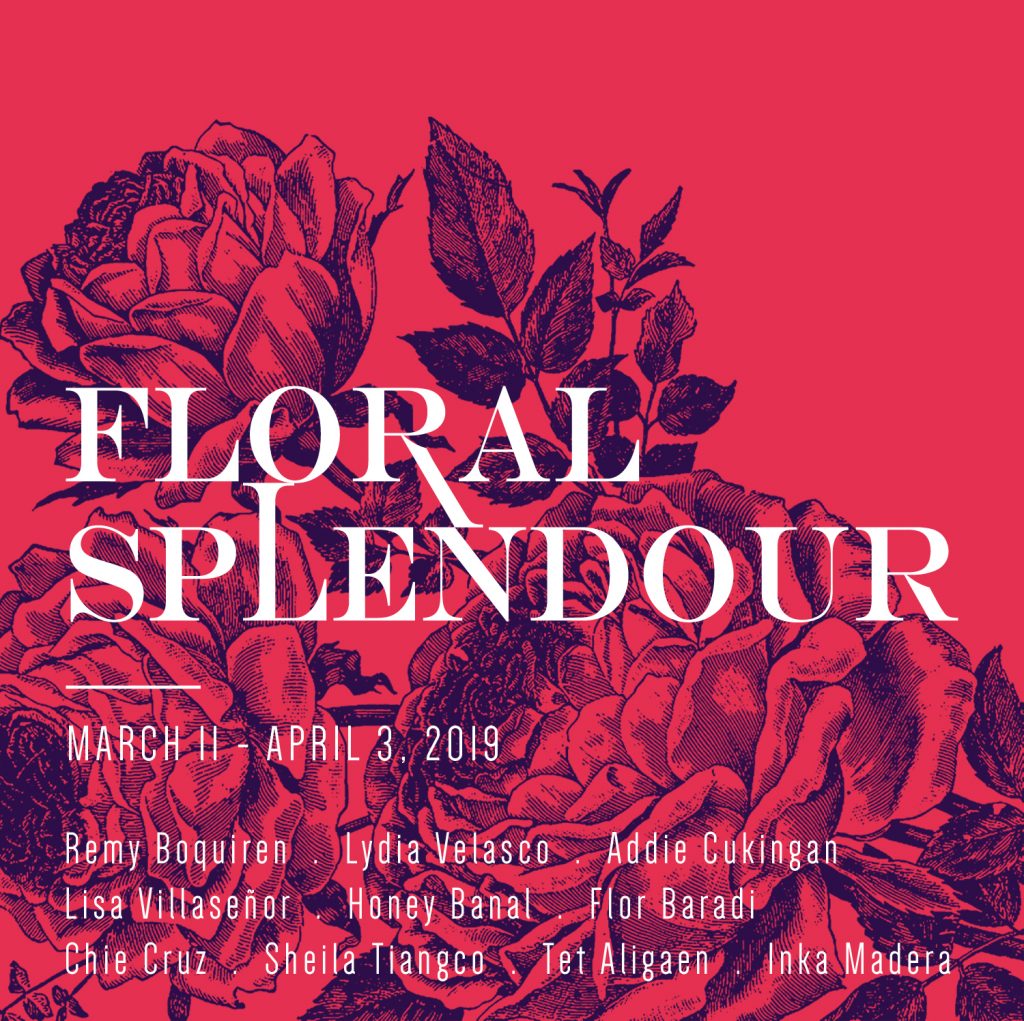
- This event has passed.
FLORAL SPLENDOUR at NCCA Gallery
March 11, 2019 - April 3, 2019
FLORAL SPLENDOUR
Remy Boquiren | Lydia Velasco | Addie Cukingan | Lisa Villaseñor
Naomi Banal | Flor Baradi | Chie Cruz | Shiela Tiangco | Tet Aligaen
Inka Madera
NCCA GALLERY
633 Gen. Luna St. Intramuros, Manila
March 11- April 3, 2019
FLORAL SPLENDOUR: Working Like A Charm
By Cid Reyes
“Bulaklak…kay ganda ng bulaklak…dulot s’atin ay galak…”
–George Canseco
“Every flower is a soul blossoming in nature.” –Gerard de Nerval
“There are always flowers for those who want to see them.” –
Henri Matisse
Take it from the founder of Impressionism, Claude Monet: “I must
have flowers, always and always!”
Indeed: which living creature, of whatever age, in whatever place
on God’s beautiful earth, has not succumbed to flowers’ uplifting
beauty and gloriousness, seduced by their vibrant and vivacious colors?
Throughout the ages, since antiquity, flowers have been an everlasting
presence in the handiworks of mankind – from the ancient Egyptian
papyrus paintings and ceramics, the mille-fleurs, or “thousand flowers”
tapestries, the Medieval illuminated manuscripts, the Italian
Renaissance mythological paintings of Sandro Botticelli, the 16 th century
Dutch and Flemish floral arrangements, the waterlilies of Monet and
the sunflowers of Van Gogh, down to the 20th century works of
Georgia O’Keefe and the Pop silkscreen paintings of Andy Warhol.
Closer to home, our very own Juvenal Sanso painted, until the
twilight of his years, his own distinctive flowers. Like Monet, Sanso,
ever the prolific artist, has shown by the plenitude of his lifeworks, that
he must have flowers, always and always.
Inspired by the flower’s timeless appeal and allure, the National
Commission on Culture and the Arts (NCCA) presents “Floral Splendor,”
a bouquet of paintings done by an all-woman group of artists.
Participating artists are Tet Aligaen, Naomi Banal, Flor Baradi,
Remy Boquiren, Chie Cruz, Addie Cukingnan, Inka Madera, Sheila
Tiangco, Lydia Velasco, and Melissa Villasenor.
**********************************************
Tet Aligaen
“As a lotus flower is born in water, grows in water and rises out of
water to stand above it unsoiled, so I, born in the world, raised in the
world having overcome the world, live unsoiled by the world.” – Buddha
More than any flower, the lotus is transfixed in the history of
Buddhism and Hinduism. The lotus is even mentioned in the Bible, in
the book of Job. An aquatic plant, it is rich in symbolism, representing
purity of body, speech and mind. It is said that the Buddha could walk
anywhere and forthwith, lotus blossoms will appear. The Confucian
scholar Zhou Dunyi wrote: “I love the lotus because while growing from
the mud it is unstained.” India and Vietnam adopted the lotus as their
national flower. Steeped in murky waters and mud but nonetheless
rising out clean and pure, the lotus emerges as a theatrical spectacle of
nature.
As the water lily was to the French Impressionist Monet, so is the
lotus for artist Tet Aligaen. She has christened her lotus paintings by the
time of day in which the lotus, having preened the whole day long,
commences to enfold itself into the darkness of twilight. Thus, the
works are caught at a tender moment, at the day’s last gleaming.
More impressively, Aligaen has even transfigured the lotus into a
piece of copper sculpture: a large scale long-stemmed flower lying
supine, reposeful, on a table top.
Naomi Banal
“No Ordinary Flower” is how Naomi Banal titled her floral works.
“Inspired by the simplicity of pressed flowers” is where their origin lies.
Naomi Banal essentializes her subject by reducing its form to its most
arresting design: the petals flaring out into a corolla, the cluster itself
radiating into abstract shapes, impervious to any defining botanical
species. Thus unnamed, Naomi’s flowers are unconstrained,
uninhibited, able to float in undetermined space, awash with the
wettest of pigments, flooding and bleeding into each other, their
fluidity restrained only by the artist’s designing intelligence. Thus
treated as abstraction, Banal’s flowers have been set abloom, radiantly
inflorescent.
Flor Baradi
In a brazen volte face stroke, Flor Baradi’s unexpectedly rejected
color in her works, in effect denying the charisma of chroma – the
propulsive potency of the image. (Can one even imagine a black and
white rainbow?) After all, is it not color that is the crucial imperative
which the very subject demands of every artist? To visualize a flower
purely in starkest black and white, in pen and ink, divorced from the
very source of its allure, is not an act of treachery and betrayal, but is
in fact one of unapologetic homage to the subject. By her strict
observance of a floral form, Baradi has become more sensitively aware
of the act of drawing, realizing that she has indeed found her ideal
vantage point of admiration and meditation of her subject.
Remy Boquiren
In triptych format, Remy Boquiren arrays the theme of the classic
“Three Graces.” Based on Greek mythology, it celebrates the three
daughters of the god Zeus and Eurynone, namely Aglaia (elegance,
brightness), Euphrosyne (mirth, joyfulness,) and Thalia (youth and
beauty. From the famous neo-classical sculpture of Antonio Canova,
down to the works of Peter Paul Rubens, Pablo Picasso, and our very
own National Artist BenCab, the image of the entwined sisters has
charmed us through the centuries. Remy Boquiren is no exception, as
evidenced by her own native version where the Three Graces have
been transfigured into demure and winsome Filipinas, clad in native
attire, and delicately posed amidst a garden abloom with vegetation
and flowering plants. The bristling Bird of Paradise, with deep orangey
hues, inflects the scene, even as the three Filipinas are each lost in
reverie in the lush bosom of Mother Nature. Another is a Cordilleran
maiden rendered in sheer incandescence of light as if she were
possessed by the spirit of an ethnic nymph.
Chie Cruz
“A flower is a literal color bouquet, spanning the entire spectrum. But
beyond the obvious visual appeal of vibrant colors, I am fascinated by
their formation, with their petals budding outwards from the middle. I
find myself so captivated by their minute details. But why do we harvest
and cut flowers before they are able to bring forth their seeds? They just
wilt and die. It is the flower’s beauty that is the greatest danger to itself.
My paintings are my tribute to the tenacity of flowering plants, ever
evolving to bring its next generation.”
While some painters may focus on the still beauty of flower, Chie Cruz
engages herself with its fascinating motion, the flowing of petals in a
centrifugal display of movement, budding outwards, or wavelike upon
each other, or shifting and stirring. She catches their movement in mid-
efflorescence, as if the flower were hesitating to burst forth, the very
expression of modesty and shyness – it will not be rushed – until,
hastened by the sun and the rich loam, the flower announces its
magisterial presence and breath-taking flamboyance, ready to enthrall
the viewer. Compositionally, Cruz depicts flowers as a crossbreeding
between the representational and the abstract, and finds no
contradiction in the process.
Addie Cukingnan
The signature floral painting of Addie Cukingnan is a white
magnolia nestled around an antique Chinese blue-and-white porcelain
vase. An allusion to her Chinese ancestry, the vase itself is a canvas for
floral decoration, providing an interesting contrast and parallel, in
surface: the smooth polish of the glazed vessel and the pearlescent
petals of the magnolia. Essentially, what Cukingnan paints is a still life, a
genre of painting familiar visually to the public – an arrangement of
inanimate objects on a table top – though the audience may not be
familiar with its history, dating back to ancient Greco-Roman times. The
word is derived from the Dutch stilleven. Not surprisingly, flower
painting flourished in the Dutch Flemish countries, especially in the
sixteenth century.
The artist paints in the silence and solitude of her studio in Tanay,
Rizal. Painting still lifes is for the artist a solacing activity. With her
quietly considered floral works, Cukingnan brings to mind the opening
words of Desiderata: “Go placidly amidst the noise and haste, and
remember what peace there may be in silence.” Addie Cukingnan
paints the stillness of her magnolias and Chinese vases.
Inka Madera
“As an artist, I tend to navigate the physicality of my subject. To me, the
real beauty of a flower relies on its relation to human experiences and
perception. I imagine the possibilities of altered realities to bring it into
a new illuminated imagery where coexistence is evident. The flower
blooms and withers, and so doI I!”
Inka Madera’s inspiration is the flower Amaryllis Belladona. The
very name sings a seductive siren song. But Madera warns: “It is
beautiful, yet a poisonous one.” And what a calamitous end lies in store
for the innocent viewer, a very victim of a fatal yearning. And such
sheer allusions to Snow White’s poisoned apple, or for Christian Dior’s
luxe potent perfume. Succumb to Madera’s floral image: the toxic
belladonna…the deadly nightshade…
Sheila Tiangco
The solidity of Sheila Tiangco’s floral work comes from her utmost
respect for the eloquent patterns of her lines upon which she has total
control. The viewer senses that the artist had the whole vision of the
flower already realized even prior to the first moment’s touch of the
brush on the canvas. The approach is craftsmanly without being
turgidly inflexible, without looking “made to order” by nature. The
artist is never seduced by a flower’s vaunted power to intoxicate the
aesthetic senses, which, when pitched to an over-the-top voltage, will
reach a level of visual shrillness that can instantly negate the delight
and charm, the lure and enchantment we expect from a floral image.
Lydia Velasco
“I paint because there is in my soul love and caring. I want to show the
inner strength of a woman, and to give beauty to life.”
The floral works of Lydia Velasco are inevitably, irresistibly,
colored, in many senses of the word, by her paintings of women. This
writer once observed: “Perhaps the best compliment one can give the
women paintings of Lydia Cruz {as she then signed her works} is to say
that they were painted by a man. But before the feminists start pelting
us with palette knives, the statement simply means that the works do
not betray the gender of the artist.” Indeed, in Velasco’s works, the
flowers never really were a dominant presence. Writers have often
commented on the “masculine” quality of her women, with their
massively rendered physiognomy. Thus, in the work that represents the
artist in the show, the flower asserts its presence, in a decidedly
unfrilly-fashion. Like a gaping orifice, with its quaking ardor and avidity,
Velasco’s flower beckons the viewer, a voluptuary, into a pleasurable
aesthetic paradise. (The flower, after all, is the plant’s reproductive
structure, effecting pollination.) The women of Velasco intermingling
with a flower is the very sight of sexuality and spirituality. From these
universal forces is distilled the inner strength of a Velasco woman.
Melissa Villasenor
It is commonplace to assume that an artist chooses a particular
flower as the central focus of her art, responding to its renowned,
peculiar, or enchanting attribute. To be sure, distinct floral forms and
colors will appeal as a particular challenge to an artist. But may it also
be said, rather mystifyingly, that it is the flower itself that chooses the
artist, insinuating itself in the subconscious through memories that
could be dredged in the artist’s childhood and youth? Such things as
places, experiences, associations, even scents, may surface unbidden,
triggering an unexpected impulse in the artist.
For Melissa Villasenor, the bougainvillea is the flower of
profusion, a most appropriate claim as the word derives from the Latin
profusionem, meaning “a pouring out.” Indeed, the bougainvillea
proliferates in an outpouring of paper-thin petals, transparencies of
light emitting as it were from the flower’s epidermis. Like a humongous
bouquet, the clusters of petals are massed together in an explosion of
color. Furthermore, the bougainvillea’s lack of self-preciousness is
especially appealing: it is to be found in unabashed plenitude on side
roads, walls, rooftops and metal drums filled with soil. Thus blooming in
vivacious shades of red, orange, pink, and white, the lush and lavish
bougainvillea bursts in resplendence in the artist’s canvases.
Literally a stamp of approval is the printing of Melissa Villasenor’s
“Pink Bougainvillea” as a Philippine postal stamp.
Cid Reyes is the author of choice of National Artists Arturo Luz,
BenCab, J. Elizalde Navarro, and Napoleon V. Abueva. He received a
“Best in Art Criticism” Award from the Art Association of the Philippines
(AAP). In 2015, he was chosen as the “Most Outstanding Kapampangan
in the Arts.” An accomplished artist himself, Reyes has held 20 solo
exhibitions.
Floral Splendour is open to the public from Mondays to Sundays ,
March 11 to April 3, 2019 at NCCA Gallery, 633 Gen. Luna St.,
Intramuros Manila ( at the back of San Agustin Church)
For inquiries you may reach us at 527-2192 loc. 324 & 328 or
email us at [email protected] ; [email protected] visit our
website :www. ncca.pgov.ph ; nccaofficial for facebook







